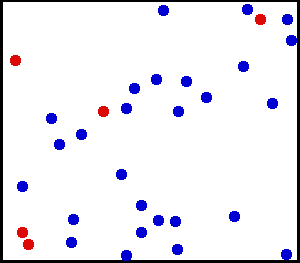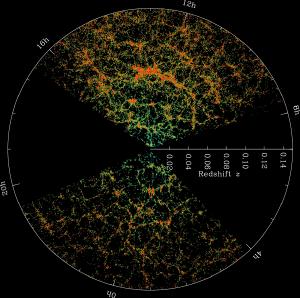Blog
Cold and Dark
16 January 2020
 TNG Collaboration
TNG CollaborationDark matter has long been one of the most mysterious things in the cosmos. It was first proposed in the 1930s as an idea to address stellar motion in some galaxies. The first solid evidence of dark matter was gathered by Vera Rubin, who studied the rotational motion of galaxies. The motion of these galaxies didn’t add up unless they contained a large amount of unseen mass. There must be some exotic, invisible matter unlike anything known before.
If dark matter exists, then it must have two major properties. First, it cannot interact strongly with light, otherwise we would see it and it wouldn’t be “dark.” Second, it must interact with other matter gravitationally, to make visible matter move in strange ways. We know of several things that satisfy those conditions, such as neutrinos or tiny black holes, but these can’t be dark matter. We know this in part because we are now able to take its temperature.
While some astronomers have proposed alternatives to dark matter, such as certain “modified gravity” models. These don’t agree well with observations. Dark matter doesn’t just affect the rotation of galaxies. Like all mass, it deflects light gravitationally. By observing the gravitational lens effects of galaxies, we can map out the distribution of their dark matter. Dark matter also affects how galaxies cluster together. In other words, dark matter drives the large scale structure of the universe. From observations of galaxy clusters, we find that dark matter appears to be cold.
 Greg L at English Wikipedia
Greg L at English WikipediaFor an ideal gas, its temperature depends on how fast the atoms are bouncing around. The faster they move, the more kinetic energy they have, and the higher the temperature of the gas. The temperature of a gas also depends on the mass of the atoms. The kinetic energy an atom has depends on the mass, so a small mass atom has to move faster than a large mass atom to have the same kinetic energy. At the same temperature, the atoms of a “heavier” gas move more slowly than those of a “lighter” gas.
Dark matter might not be an ideal gas, but we know it doesn’t interact with itself strongly, so the same general rule applies. The temperature of dark matter depends upon the motion and mass of its particles.
 M. Blanton and the SDSS
M. Blanton and the SDSSOn a cosmic scale, gravity tries to collapse dark matter into clumps, and the motion of dark matter tries to spread out due to its motion. This means that dark matter will tend to cluster into clumps. The scale at which this clumping occurs tells us the temperature of dark matter, and therefore the mass of its particles.
The standard model of cosmology holds that dark matter is cold. This means dark matter particles have a high mass. They are often called Weakly Interacting Massive Particles, or WIMPs. The cold dark matter model works well on the scale of galaxy clusters, but it doesn’t work as well on the scale of individual galaxies. One way to take the temperature of dark matter is to determine at what scale clumping breaks down.

Credit: NASA, ESA, A. Nierenberg (JPL), and T. Treu and D. Gilman (UCLA)
Recently a team measured this scale by looking at seven lensed quasars.1 This is where a distant quasar has a galaxy in front of it from our perspective. Light from the quasar is deflected around the galaxy like a lens. By measuring these lensed quasars, the team could narrow down the scale of dark matter. From this, they determined the temperature of dark matter, and thus a minimum mass for dark matter particles.
 NASA, ESA and D. Player (STScI)
NASA, ESA and D. Player (STScI)They found the mass for dark matter particles must be at least 5.58 keV. This is 3,000 times more massive than neutrinos, but it is nearly 100 times smaller than the mass of an electron. This latter point is interesting since most WIMP models argue for a particle mass 100 times heavier than a proton. If dark matter particles are light, then they surely would have been detected in particle accelerator experiments already.
While this study doesn’t argue against cold dark matter, it also allows for warm dark matter. The authors say they would need to look at another four dozen lensed quasars to pin things down. So you could say that the debate over cold dark matter is starting to heat up.
Hsueh, Jen-Wei, et al. “SHARP–VII. New constraints on warm dark matter free-streaming properties and substructure abundance from flux-ratio anomalous lensed quasars.” Monthly Notices of the Royal Astronomical Society stz3177 (2019). ↩︎